 By Staff By Staff
February 24, 2014
BURLINGTON, ON.
It went on for quite a while – between December 2013 and February 2014, but the Regional police were able to apprehend and charge a Hamilton resident for inappropriate touching.
The accused person had been going to the Silver City Cineplex Cinema located at 1250 Brant Street in Burlington where he engaged in inappropriate and unwanted contact with at least three different women. These incidents were later reported to Police.
The accused has been arrested and charged with the following offenses:
ACCUSED:
William DEJONG, 56, of Hamilton Ontario is charged with:
Mischief – Interfere with person in lawful use, enjoyment of property (three counts)
The Halton Regional Police Service believe that Mr. DeJong may have had similar contact with additional women at this theatre during this time period and urge victims to contact the Burlington Criminal Investigations Bureau at (905) 825-4747 extension 2316.
Anyone with information on this or any other crime is asked to call Crime Stoppers at 1 800 222-8477 (TIPS) or through the web at www.haltoncrimestoppers.com or by texting “Tip201” with your message to 274637 (crimes).

 By Pepper Parr By Pepper Parr
February 22, 2014
BURLINGTON, ON.
A report from John Duncan, Transit Manager was what staff call a “walk on” – wasn’t prepared and circulated much in advance and the public didn’t have much time to read and review the document that focused on the November 3, 2013, a significant change to the Transit route network was implemented in order to address the following concerns raised by council and transit users:
Late night service;
Extended holiday service;
Increased frequencies on high demand routes;
Improved service to employment corridors;
Improved connections to GO rail service; and,
Route inefficiencies.
City council was having a problem with transit and the public was divided: people would complain that they saw buses going up and down the streets empty, transit riders complained about the poor service and the transit advocates said the problem was underfunding.
Council and the city finance people were looking at the amount of money being spent and a system that didn’t appear to be delivering what was needed.
The then director of transit advised the city she wanted to retire which left things in a bit of an awkward state as the city transitioned from one transit director to the next.
Mike Spicer, who was on staff at transit was appointed the new director of transit. He needed some time to get a stronger grip on what had been happening and then to assemble the staff he felt were needed to implement the changes. Spicer has been the voice for transit at committee meetings.
City manager Jeff Fielding directed Spicer to modify the routes and get more coverage with the same fleet. The transit users felt the changes were close to draconian. Fielding wanted more data so fact based decisions could be made. The public would watch council chatter away for an hour over the five or six complaints over service on a particular bus route yet pay little attention to the several hundred people using the route.
 Last November the transit people introduced a new schedule with a lot of changes – and that took time for people to adjust to the different routes and schedules. Last November the transit people introduced a new schedule with a lot of changes – and that took time for people to adjust to the different routes and schedules.
Transit had to find efficiencies in order to fund improvements and provide service in other areas of the Transit network; that meant reallocate existing available resources. This was accomplished through the reduction or elimination of service on some routes, based on underutilization.
Change to anything does not come easily. While the service change allowed Transit to establish a baseline service that could be built upon when future funding becomes available they also generated a substantial number of complaints: 270 that can be directly attributed to the November 3, 2013 service changes. That is 270 in a two month period for a service that carried an average of 175,000 passengers a month. That figure climbed to 350,000 during November and December.
 The amount of money Burlington pumps into its system is far less than Oakville – and it shows in the service we offer. Transit staff are struggling with what’s coming at them. The changes were made last November and they are now monitoring the usage and looking for ways where, based on the traffic count, changes can be made. What transit had to get away from was reacting to a couple of dozen complaints and having council beat them up all the time.
Spice, director of transit explained that there had been:
Limited time for transit users to become familiar with the network;
Seasonal changes effecting transit use; and,
Limited data collection window – less than three months.
Transit staff engaged from the DeGroote School of Business to assist with survey work to further understand the travel patterns, in the south-east section of the transit network, where significant changes were implemented resulting in the greatest volume of service type concerns.
 At busy holiday shopping periods buses get trapped in Maple View Mall – killing schedules. City is in talks with the Mall management. Traffic in and out of Mapleview Mall has been a disaster for transit. “when we get in there we can’t get out sometimes” explained Spicer at a committee meeting. Our buses get trapped in the mall which throws our schedule out of whack.” Transit is negotiating with the mall to see if they cannot find “bus only” access points to the mall property. Those talks do not appear to be going al that well. Time perhaps for the Mayor to pay a friendly visit to mall management; if he doesn’t hear the words transit users need – he has a “bully pulpit” he can use.
As part of the budget preparation process Mike Spicer was directed to reinstate service frequencies that were removed from underutilized routes. Because the changes in November 2013 were a reallocation of existing resources, there would be a cost associated with increasing service frequencies. Add to that the lack of additional buses or operators currently available – making it tough to get back some of the services that were cut. Spicer was between a rock and a hard place.
The transit team prepared two scenarios that identify the resource needs to reinstate service frequencies to previous levels in underutilized routes.
In Scenario “A”, Spicer reported there would be no discernible increase in ridership. Scenario “B”, showed the potential for a rise in ridership – the table sets out the approximate costs and revenue associated with each scenario:
|
ScenarioOptions
|
AnnualHRCost
(Operators)
|
AnnualOperatingCost
|
CapitalCost
(BusPurchases)
|
AnnualRevenue
|
Total
|
|
(A)Increasefrequencies
duringoffpeakservicehours
|
$481,528
|
$211,475
|
$0
|
$0
|
$693,003
|
|
(B)Increaseoverallservice
includingfrequenciesandroutes
|
$1,084,592
|
$548,938
|
$1,470,000
|
($245,000)
|
$2,858,530
|
Not hard to grasp what the issue is for council – where do they find the additional $2 million.
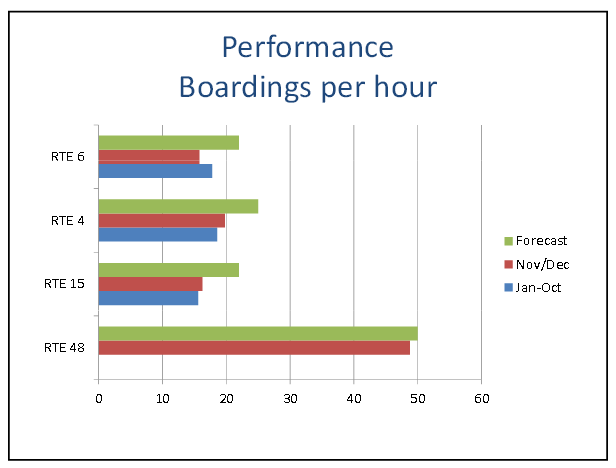 The revised routes are not meeting their forecasts yet but it is a bit too early to have sound data. Burlington isn’t a city that makes heavy use of transit; partly for historical reasons, partly because the service isn’t all that good and partly because council doesn’t believe their constituents are prepared to pay for the service.
Early in the term of this council there was a fight over the level of service in ward 5 – Councilor Sharman territory. For a while there was a battle of petitions with the transit users gathering 250+ names to continue with a service while the councilor’s followers came up with less than 50 names on their petition. The service was changed despite the lopsided numbers and there is now no longer a bus service along Spruce Avenue – which happens to be the street the council member lives on.
Spicer makes on additional telling comment in his report: A funding source has not been identified to reinstate or supplement transit service levels. The report adds that there just isn’t enough data in yet to know what needs to be changed and doesn’t support throwing money at a problem that isn’t as clear as the transit advocates want people to believe it is.
Prior to the November 2013 service changes, a number of public engagements, notification and education initiatives were undertaken. These included:
Public information sessions on September 7th and 8th of last years at the Burlington Mall; the Bfast people (Burlington For Accessible Sustainable Transit) say these session were a bit of a joke. Transit used Social Media – Twitter; Local television and newspaper; the Transit website; Email alerts to subscribers; Bus destination signs and posters; items in the City Update; Media releases along with Transit Operator bulletins, postings and letters.
Add to that a group of 20 Transit Operators who engaged the public to review and discuss the service changes prior to implementation. And yet there is still a significant amount of dis-satisfaction over the levels of service.
Transit staff are not recommending any change or increase to transit service levels until sufficient system use data can be collected for analysis and a growth strategy can be prepared for council review and approval.
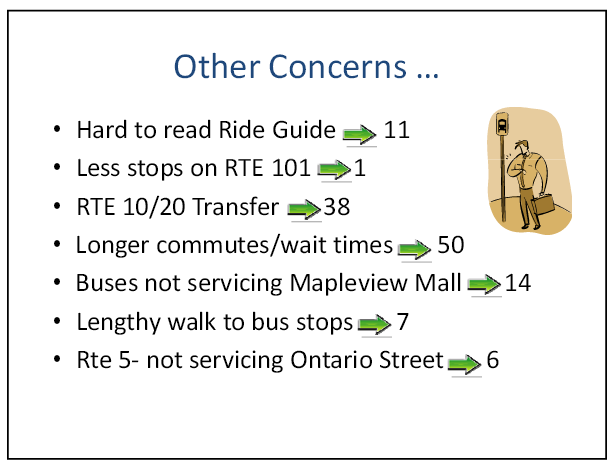 The 270 complaints recorded don’t appear to be very high – not until they are put into perspective – the number is for a two month period only. A couple of members of council had a little trouble digesting the fact that the transit service will be paying bus cleaners $65,000 a year. They will be defined as “mechanic’s helpers” and will also fuel buses and do other related work. Councillors Dennison and Taylor choked on that rate of pay. Director Spicer explained the situation he was in with the outside bus cleaning firm and council went along with him.
This looks like one of those situations where everyone has to wait until there is sufficient data – and that takes time. Once the data is in hand, transit would be well served to hold a Saturday workshop that is broadly promoted where the data can be discussed by staff and the people who use the busses.
In the past we have seen public events on transit with few, in one case in Aldershot no one showed up, in attendance. People later said they didn’t know the event was taking place. Far too many bureaucrats rely on social media believing that is the answer to all their information and communication needs. What amazes us is that transit doesn’t use the bus drivers to promote the meetings. Why not have the bus drivers hand out transfer size piece of paper to each passenger as they get on the bus – talk about having your target market right in front of you.
It would be effective and a lot cheaper than advertising or taking up space in city publications that are poorly read.
Transit is said to be in transition – many are not sure it is transiting in the right direction.
Background links:
What kind of transit service will the city have for seniors?
Bfast wasn’t impressed with the last-minute transit report.

 By Pepper Parr By Pepper Parr
February 23, 2014
BURLINGTON, ON.
The process Burlington Transit is going through as they rationalize their routes and look for more efficient ways to serve the needs of those who choose to use transit and those who have no choice got me to thinking longer term.
Stay with me on this.
Students or first time drivers have to go through a graduated license process and don’t get to drive on the 400 series highways the moment they pass their first test.
 It will not be too long before rules like that are going to apply to seniors. I personally find that my eyes don’t work the way they used to in the dark of night and my reflexes aren’t as sharp as they were when I was 25. It will not be too long before rules like that are going to apply to seniors. I personally find that my eyes don’t work the way they used to in the dark of night and my reflexes aren’t as sharp as they were when I was 25.
I frequently find myself driving behind a senior who gives the word cautious a whole new meaning. There is timidness to older drivers and once there are more of them on the road – and that day is not far off – traffic is going to move slower.
Between older people driving slowly and young people believing they can text and drive, the roads in town will become hazardous places. But that is not my point.
 We will need buses that can carry dozens of people with walkers – because they won’t be driving. I believe there will come a time when the province will require doctors to report any patient whose responses are such that they perhaps should not drive at night. Many of you know of adults who have had to go through the difficult process of telling Dad that he has to give up the keys to the car and not renew his driver’s license.
What do those seniors do then? Are they to be land locked in their homes – because they aren’t going very far with the service Burlington Transit offers?
It doesn’t require a degree in rocket science to figure out how many seniors we have and where they live – the federal census data will give you that information. We already know in large numbers how many seniors we have and which postal code they live in.
We know where the libraries are, where the food stores are and where the hospital is. If we know the ages of the people in this city, and we know where they live and where they will most likely want to go – then we can begin thinking about what kind of transit we are going to need to move these people around.
That is the kind of long term thinking a city council should be doing. I have watched and listened to council members discuss how many people were on a particular bus route at a specific time – none of their business – that’s what the transit people do.
Council’s job is to think today and plan for tomorrow on how the city is going to meet the transit needs of all the seniors that we are going to have living in the best medium size city in the country.
 Specialized buses will be needed and it will take longer to load passengers. When the capital budget for the next 10 year is drawn up there should be funds set aside to buy the kinds of busses the seniors will need. We need to begin putting money into that reserve find now and doing some early education work as well.
Perhaps we will see a Staff Direction to this effect sometime soon?
Will Burlington lead in the transit service it provides its seniors?

 By Pepper Parr By Pepper Parr
February 22, 2014
BURLINGTON, ON.
There will be a heritage planner – a full time heritage planner but getting the position secured was easier said than done.
The question in front of city council as they worked their way through the budget was: how much did they want to spend on a heritage PLANNER – $206,000 or $103,000.
The city already has a heritage planner who spends half of her time on heritage matters and the rest of her time on other planning work; she is swamped. She gives the city far more time than she gets paid for and has done a lot of superb work.
Heritage has become a sort of favourite flavour of the moth in this city. The Heritage Advisory Committee is much more active – at times they think they need a full time planner. When the decision was made to go forward with the idea of a Conservation Heritage District for the Mt Nemo Plateau the work of the heritage planner suddenly got much bigger.
The question then was – how much staff resource are needed? For some reason council wanted to get right into the weeds on this one. They first talked in glowing terms about the job the current heritage planner has been doing and then began to map out her career for the next ten years until they were told that wasn’t council’s job.
 It was about 15 months ago that rural Burlington began the discusion about what it wanted to be. Some things were clear – others not as clear. The early draft of a vision got put on a huge board and for the most part the community liked the look of what they had said to each other. Council had gotten into the weeds on this one the way they do far too often. For a bit it looked like they were going to start running the department. Should the current planner become full time on heritage? a full time role and contract someone for an additional half day; no that’s not good use of human resources. OK look for someone within the department and have them pick up the development work the planner was doing – the rationale for that view was that development is off so there must be bodies in planning with nothing better to do.
General manager Scott Stewart who signs off on everything that comes out of planning, struggled to get a grip on all the ideas flying around when the city manager pipes up with his position: it isn’t pretty.
“You don’t Jenna, she does; she decides what she wants to do. You have asked us to manage – then let us manage; that is not your job; this is not the type of discussion we should be having; you have me here to tell you things like this.”
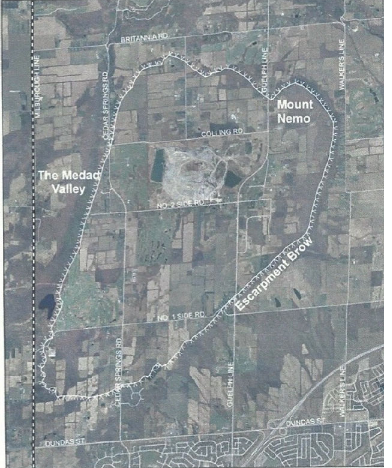 A heritage planner was critical if a Conservation Heritage District bylaw was ever to get passed. First part of that effort got through a Standing Committee. The proposal to think about turning the Mt. Nemo Plateau into a Conservation Heritage District which is just at the information gathering stage will require a lot more of a planner’s time. That file has the potential to become a lot messier than it would at first appear – when individual land issues are on the table get ready for noisy meetings.
Councillor Taylor is a big advocate on for making the plateau a conservation district – he wanted the planning resources available.
While council was digesting that blast from the city manager, Scott Stewart the general manager invited the Director of planning to “take it outside” where they worked out the possible time/task splits
The proposal was to have 1.5 heritage planners – then it looked like they were looking at two planners. Then there was a tussle over what this planner would be doing. The issue was where the planner was going to come from and the amount of work that was going to get created by the Mt. Nemo Conservation District task that is now on the table – or look as if it is going to be on the table.
A motion to hire more people failed, the amended motion to make the existing half time planner into a full-time position and distribute other work she was doing within the existing staff compliment passed 6-1 with Taylor voting against the decision made. He wanted more in the way of human resources than his colleagues were prepared to pay for.
 Residents look at a large map of their community during a Rural Summit more than a year ago. That meeting was the genesis of making the Mt Nemo Plateau a Conservation Heritage District. Some members of council wanted to know why staff just didn’t do the staff allocation. It was a new position – they were moving from a half time heritage planner to a full-time heritage planner and that was a decision council had to make, explained director of finance Joan Ford. What Ford was trying to say in a polite way was that council had to decide on the expenditure – staff would then decide who should be doing the job.
Councillor Meed Ward said she had “difficulty with the process that got us here”.
Was the spend going to be $103,000 or was it going to be $206,000 and would the new position be added to the base staff compliment or would they go outside and contract with someone, or would they look within the planning department and find someone who wasn’t all that busy.
Councillor Lancaster thought the city was moving too quickly on this file. Her view was that council needed to be more reflective and to take some time. But that wasn’t the view that Councillor Taylor brought to the horseshoe. The Conservation District would be in his ward and he is fully aware as to just how powerful the people in North Burlington can be. They were the folk that hung in and fought the Nelson Aggregate quarry expansion. Those people know how to dig in and for them a Conservation District would solve a lot of their concerns or they think it will.
 It took $2 million out of the legal department’s budget to pay for the tear long tribunal that decided the Jefferson Salamander was important and that an expansion of the existing quarry should not be permitted. It was rural Burlington residents who were the force behind that battle – they were not to be trifled with. The expansion to the quarry was going to be in the lower part of this topographical map Councillor Dennison said that “we didn’t ask for this, we don’t need to get all gung-ho about it. He wasn’t all that keen on the “foremost specialist the city hired to do the first cut of the research presented at the January meeting. Get ready to see this as a file that becomes very contentious.
At the community event in January city planner Bruce Krushelnicki explained that a Heritage Conservation District was created through a bylaw passed by the city. No one else has any input on that bylaw he explained. The city can pass a bylaw to create something and they can revise that bylaw anytime they wish.
What the planning department has to do is do the research necessary to figure out how best to craft a bylaw that will stand up to scrutiny – and at the same time ensure that the community wants such a bylaw and understands the ramifications. There are both ramifications and consequences – some of them unintended.
Once e a bylaw is in place it tends to take on a life of its own – which is what the rural life advocates want to see.
Making that happen requires a lot of hard work, a lot of research and a lot of public opinion massaging.
The first battle was to get the planner in place so that some of the early research work could get done.
There will be a planner, working full-time on heritage matters. The planning department will figure out a way to reallocate day-to-day work in the department.
Our significant seven weren’t seen at their best on this issue and they needed the sharp rebuke from the city manager to remind then what they were supposed to be doing.
At times one wonders how we manage to stay out of serious trouble.
Background links:
Rural Burlington figures out what it wants to be.

 REVISED REVISED
By Pepper Parr
February 22, 2014
BURLINGTON, ON.
They weren’t able to bring it home on Thursday, so they will get back at the budget March 4th and hopefully have it done then. There is still a lot to get through.
Council steps back from the budget deliberations to turn their focus on the day-to-day business of the city. Monday is Development and Infrastructure; Tuesday is Community and Corporate Services.
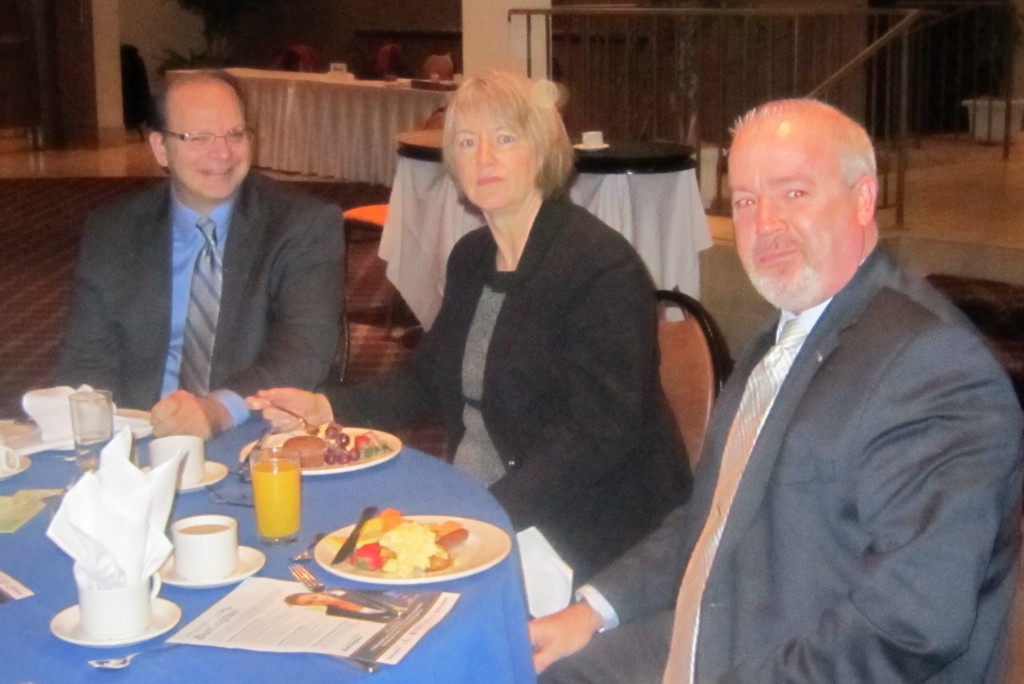 City administration leadership team: city manager Jeff Fielding on the left with general manager community and corporate services, centre and general manager, development and infrastructure Scott Stewart on the right. Is it a cohesive team pulling together to achieve a goal shared by all. Some doubt that. Immediately following the Community and Corporate Affairs committee meeting council will meet in the Mayor’s Board room to hold a “Discussion concerning the City Manager’s Performance Evaluation.”
City manager Jeff Fielding has been holding their feet to the flames the past couple of months. Is there a genuine concern on the part of this council on the performance of the city manager? That would be a major ‘cock up’.
The city came to an “understanding” with the former city manager that he should not complete his five-year contract which led to the hiring of Jeff Fielding who is in the process of completely changing the way the city handles its finances and the way it serves the citizens. While it is difficult at this point to fully understand what Fielding has in mind (some staff members still don’t comprehend the new approach) the centre piece is Results Based Accountability by which Fielding means citizens will know who owns a service being delivered with that person being personally responsible and accountable – certainly something new for this city.
What is a little surprising and a bit disconcerting, is that council would stick a meeting to discuss the city manager’s performance in the middle of a very busy week that will handle the most important piece of business this city has to face.
And so, at a time when council is only part way through its budget for 2014 it pauses to gather in the Mayor’s Board room for a: Discussion concerning the City Manager’s Performance Evaluation.
This is either sloppy agenda management – or there is something up.
We have been advised that this meeting was scheduled at a time when council expected the budget meeting to last just the one day. We are also advised that the city managers performance is reviewed on the aniversary of his taking on the job and is “ pretty standard stuff”. The process is to review performance annually on anniversary date. It is a standard annual performance review and a discussion on future objectives.

 By Pepper Parr By Pepper Parr
February 21, 2014
BURLINGTON, ON.
There isn’t going to be a Cultural Manager in Burlington during 2014 – perhaps in 2015, but a Standing Committee just didn’t see a compelling case for hiring a new person for a job that wasn’t as clearly defined as it could have been.
The arts and culture community brought its existence to the surface – the city learned a lot more about who they were, what they are and what they do. Their lobbying efforts blew hot and cold. They certainly pulled the Mayor into their circle – but that wasn’t enough.
Staff, particularly general manager Kim Phillips, who is the lead on culture in the city, didn’t do all that much to support the creation of the position.
Council seemed to feel that a full-time cultural planner was enough for now and would revisit the needs of the cultural community next year.
 What was nascent and budding – has been stunted at the administration level. It is going to be up to the artists to create whatever structure is needed. What the city will see is various initiatives – and there is some very solid work being done by individual artists, but people who are not always the best at administrative stuff aren’t going to be able to market and move the idea that Burlington is a legitimate cultural centre forward very much. What was nascent and budding – has been stunted at the administration level. It is going to be up to the artists to create whatever structure is needed. What the city will see is various initiatives – and there is some very solid work being done by individual artists, but people who are not always the best at administrative stuff aren’t going to be able to market and move the idea that Burlington is a legitimate cultural centre forward very much.
There is some hope but it doesn’t exist at council nor at the senior staff level.
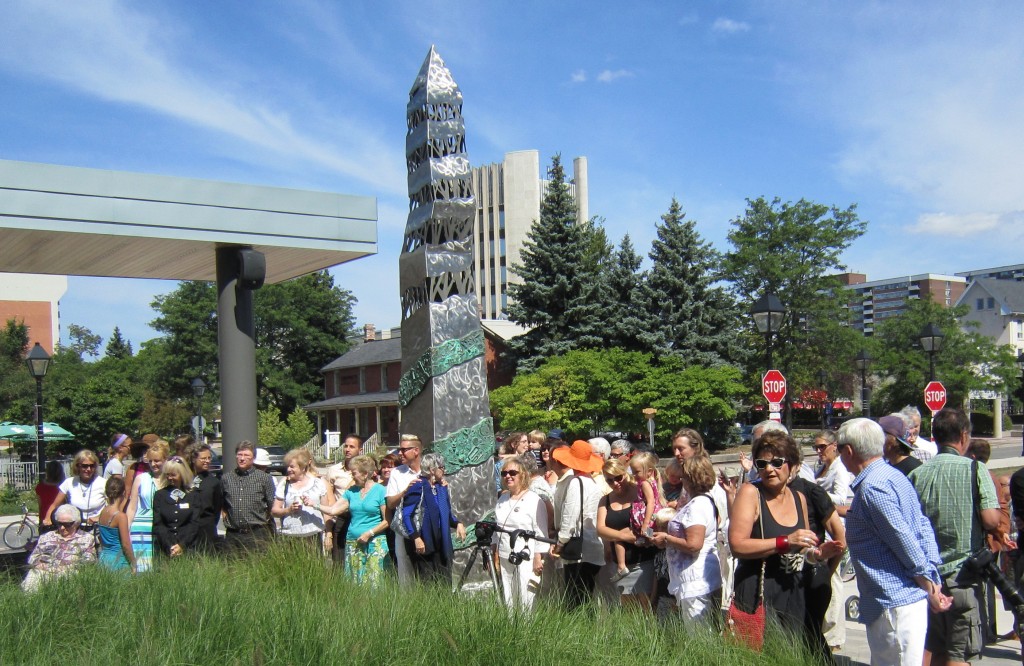 The unveiling of the Spiral Stella outside the Performing Arts Centre on a bright summer day was thought to be the beginning of a breakthrough point for the arts and cultural community. Hasn’t worked out that way, yet – but art perseveres – their day will come. Discussion on this item that was on the books for $128,000 + a one time set up cost of $8,320 started with Councillor Lancaster saying she was not on for this one – mostly because she didn’t think there was all that much to manage –and on that point she was right. The arts community saw this as a person who would do some ground breaking and seed planting.
Mayor Goldring followed Lancaster saying he would not support the expense – at least not this year. Councillor Sharman said he was where the Mayor is – not at this time.
Councillor Craven wanted to know what the impact would be without a Cultural Manager – he seemed to think that with the cultural planner in place whatever had to be done would get done.
General manager Phillips conceded that the Cultural Action Plan that Council has approved will certainly proceed much slower. She added that there is some cultural mapping being done –people are adding data on who they are and what they do to the web site.
Councillors Taylor and Dennison took a pass – made no comment.
 The city’s cultural planner is all the arts community has at this point. There is some cultural mapping being done – which is useful in itself but won’t do all that much to build the tremendous potential culture has in this city. Angela Papariza will use her well-developed culture background and training to work with people like Trevor Copp – not likely to see much more in 2014. For Councillor Meed Ward – it was also a “not now – re-evaluate later” an odd decision given that much of the cultural activity is in the downtown core which is her bailiwick. Meed Ward could see where this was going.
The question now is – what is the cultural planner going to do? The current occupant of the position certainly has cred within the arts and culture community but Burlington has had good people working the culture file in the past – and they have all moved on.
The hope for many was that with the surprising energy that was seen within the arts and culture community (it was always there – just not seen or appreciated) the time had come to get serious and develop the opportunity.
The Arts and Cultural Collective did as much as they could – and then some. Trevor Copp sent out a last-minute plea to the Collective membership: “Without this position, Arts & Cultural Grants, an outside Arts body, use of space and bylaw reviews in our favour is seriously jeopardized. All our work may go up in smoke. Let them know how you feel please”.
What happens next will depend on the kind of energy and leadership that comes from the general manager handling this file. Don’t get your hopes up.
Background links:
Turns out the art community didn’t get anything from the cookie jar.

 By Pepper Parr By Pepper Parr
February 21, 2014
BURLINGTON, ON
James Smith, the man who led the Friends of Freeman Station to where it is today and a leader in the transit advocacy community and one of the better delegators in the city did a no,no,no at the Thursday Standing Committee reviewing the current portion of the city budget.
Smith was one of five people delegating on two late arrival staff reports that impact the budget and was delegating on the transit report, which wasn’t all that bad a document.
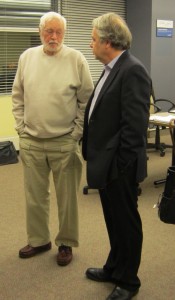 The late Les Armstrong, one of the strongest advocates for the Freeman Station revitalization chats with James Smith on the right. Smith took to the lectern and didn’t start with his usual polite “how ya doin” introduction but said he was going to depart from his prepared remarks and speak extemporaneously and then asked if the people who wrote the transit report were on crack cocaine?
Some in the council chamber wondered if Smith thought he was delegating at Toronto city council. He continued in the same vein until committee chair Meed Ward stopped him in his tracks, read him a portion of the riot act and Smith retracted the remarks.
None of his Bfast (Burlington For Accessible Sustainable Transit) colleagues could understand why Smith behaved as he did. “He wasn’t speaking for us” explained Bfast chair Doug Brown.
Any plans Smith had for a run against Councillor Paul Sharman in ward 5 now need a serious re-consideration.
The lingering question over the exceptionally poor behaviour is – why?

 By Pepper Parr By Pepper Parr
February 21, 2014
BURLINGTON, ON.
In the old Soviet Union, if you didn’t deliver they took you out and shot you. The Soviets have cleaned themselves up and the Koreans now do that. Sweden has always been a kinder softer country – but bet everything you have on someone at IKEA having to refresh their resume over the massive screw up on the decision to look at the North Service Road property as a possible new home for them in Burlington.
Multi-national corporations don’t make mistakes like this. IKEA has a brand, we now call all the strong brands iconic these days, that they promote heavily. They wanted that brand visible from a roadway where there is loads of traffic. Thus the decision to find a property along the QEW. That part of the decision making process IKEA went through may have been the only part that made sense.
There were problems galore with the site – there were also a lot of problems with the way IKEA said they wanted to situate the buildings and parking on the site.
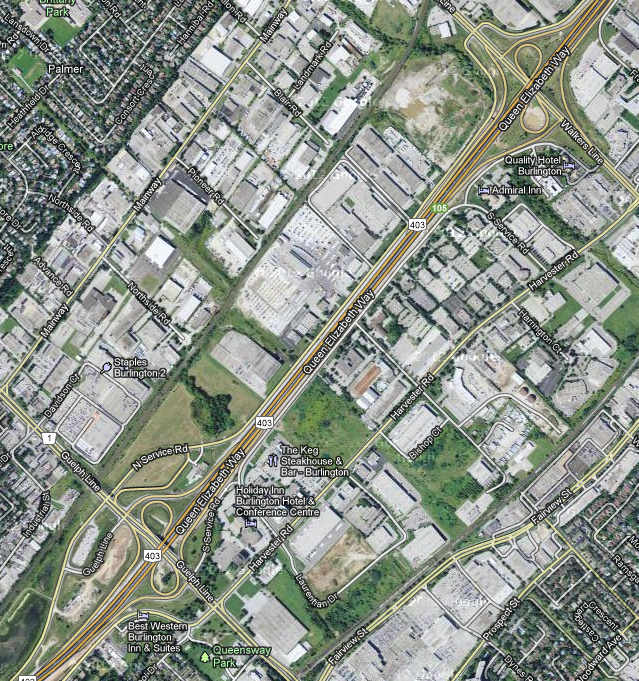 A portion of our prosperity corridor – IKEA had picked a spot close to Walkers Line. The Burlington Tourism office will tell you that IKEA was close to the #1 tourist attraction in the city; they drew from a dense and very rich market. We are the only IKEA operation west of the GTA core.
A five minute drive along the North Service road made it very clear the road would have to be widened to at least four lanes. We did that back in June of 2012 and reported on that.
A little research would have revealed that the Ontario Ministry of transport wanted more room to expand the width of the QEW and the only width available was to go north – which meant pushing the North Service road back – which would eat into the property IKEA had taken an option on.
The property has a barrier on the north side – a railway line. Walkers Line was known to be close to its capacity – so there was work to be done there. Creating a turn from Walkers Line onto the North Service Road – going both east and west was a challenge
Add to all that – the Creek that runs along the eastern side of the property.
IKEA is taking the public position that the site is not quite what they need – take that position with a grain of salt. The IKEA spokesperson assured anyone who asked that the decision was strictly based on the site. She added IKEA Canada is doing well financially.
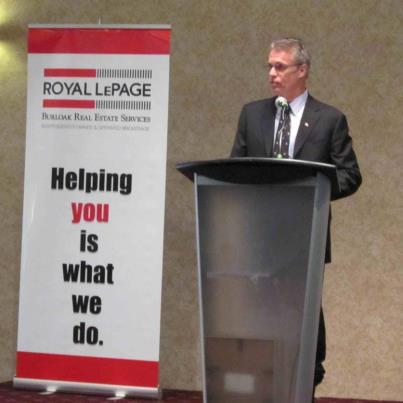 Mayor Rick Goldring Burlington’s Mayor is “discouraged” but adds that the IKEA application “did identify a need for infrastructure improvements”. It did much more than that; it showed land that was being very much under-used. Goldring does see a “silver lining” – the IKEA application showed that the transportation corridor either side of the QEW had to be improved. Did we have to wait for the IKEA application to figure that one out. The economic development master minds should have known that – and the planners could have at least suggested we pay some attention to that part of town. McMaster moving to the South Service Road should have been hint enough.
The city has managed to convince itself that IKEA pulling out has given us an opportunity to create a shovel ready site for anyone who wants to move to Burlington. Has anyone seen the line-up of people wanting to move to Burlington?
In the world of property development – two things matter: location and timing. Why it took IKEA a couple of years and perhaps as much as $1 million to arrive at the conclusion that the site wasn’t what they needed is a tough one to get ones head around. IKEA had made a decision to move. The objective was to have space for the headquarters office. They also wanted to expand the sales side and offer WHAT. All those IKEA plans are still relevant. IKEA’s intention was to WHAT and the city rezoned the property so they could do that.
IKEA lives in a competitive environment – they fight every week for market share. What they sell in this market works its way all the way back to the head office in Helsingborg, Sweden, where they are now asking a lot of questions. If some IKEA heads don’t role there are surely bonuses that will be a lot smaller.
 IKEA wanted to be bigger and a whole lot better – and that plan isn’t going to change. sooner or later – they will move from this site. IKEA has a very interesting corporate structure. At the top is a holding company in Luxembourg, tax reasons for that, with group services in Belgium, Franchise in the Netherlands, retail Centre Division in Denmark, and Finance in Sweden. The company appears to work as a series of national franchises – wonder who owns the Canadian franchise? The whole operation is owned by two parties: 51% Inter IKEA Group and 49% INGKA Group. Complex!
Burlington is trying to put the best face possible on the disaster – and make no mistake – this is a disaster for Burlington. Not only is there a major client that is not happy, even though much of the mess is their own fault, there is revenue that is lost to the city and we are now in the unfortunate position of having to pay for all of the changes needed on Walkers Line by ourselves. IKEA was going to be picking up a lot of that expense.
We have also done ourselves a lot of damage in terms of reputation. The development community knows we parted ways with the former Executive Director of BEDC. There aren’t that many job opportunities in that field; there are some good people out there but they don’t want to align their careers with loser communities and right now Burlington isn’t looking all that good.
Heaven’s Hamilton is seen as one of the top ten development growth communities and we all know how dysfunctional that city council is. Burlington has to figure out quickly what it needs to do and then do it. The problem is that the only people who can manage this type of problem are up to their arm pits with other tasks that are just as important. The city manager is a) re-casting his capital budget, b) totally revamping the way services are to be delivered and making people personally accountable –talk about a culture shift; c) reviewing the work force the city has and aligning it with the human resources we have and are going to need. He doesn’t have the time to resolve this problem and the one person he has that can do the job has his plate more than full as well. The city manager unfortunately doesn’t have the bench strength he needs to run the place and it is going to take him three years, at a minimum, to re-develop all of the human resource side of the city.
 Heck BEDC can’t get themselves to the point where they are ready to go to market and find the person they need. They have to restructure and get that approved at the May AGM. Heck BEDC can’t get themselves to the point where they are ready to go to market and find the person they need. They have to restructure and get that approved at the May AGM.
Thinking that we can wait until the BEDC AGM in May is what a high school student might try. Is that our level of sophistication?
The Mayor and Councillor Dennison seemed to have found a silver line in all this; if IKEA couldn’t work through the difficulties with the location what makes us think someone else will? The forthcoming staff report will sum up everything – but that’s about all. Bet on someone finding a way to thank someone for all the hard work that was done.
There is trouble in paradise. The silver lining the Mayor is talking about might be a thought to put the new city hall on the site. The late James Gandolfini of The Soprano’s fame had a word for ideas like that – “fu-ge-da-boud-it”
There are three IKEA stores in the GTA market, Burlington, Etobicoke, and North York. There is a store in Vaughan and a store in Ottawa. There is room to the west of Burlington for an IKEA store and Hamilton’s demographics are becoming a lot more appealing to IKEA.
While IKEA has made a decision to remain in Burlington, that may well be just a place holder. They wanted bigger and better and they put their money on the table to get that. The deal couldn’t be closed – someone else, somewhere else might come along with an offer IKEA just can’t refuse – and don’t for as much as a second think that there aren’t people out there right now figuring out how to cook up a deal.
Hamilton took International Harvester right off our plate. Are we going to see a repeat of that kind of play?
One of the smarter commercial real estate types we talked to said: “this is embarrassing”; it might also turn out to be very expensive. Add this one to the egg on our face with the pier and we aren’t looking so good right now.
Background links:
North Service road couldn’t handle traffic load.

 By Pepper Parr By Pepper Parr
February 20, 2014
BURLINGTON, ON
Doug Brown knows more about what Burlington hasn’t managed to do with its transit service than anyone else in the city. He has personal files that cover more than 25 years of transit history. He brings a strong personal commitment to public transit and can tell you how difficult it is to get about not only the city but the Region if you rely on public transit.
 Doug Brown and Susan Lewis look over a 1982 copy of the city’s bus schedule.  They called the bus schedule the Digest in 1982 – a time when Burlington had 18 bus routes and a schedule that fit on one large piece of paper. The current bus schedule is 28 pages long – many of the bus drivers don’t understand the thing. We met with Doug Brown and Susan Lewis to talk about the delegations each of them had made to the Community and Corporate Services Committee Brown brought along a copy of the 1982 transit schedule – which at that time was called the Burlington Digest
Last year Brown and a group known as Bfast , Burlington for Accessible Sustainable Transit, made presentations to the Standing Committee that was reviewing the budget for 2013. In their presentations, they presented what they believed was clear evidence that Burlington had continually underfunded transit. They presented the findings of consultants reports, and compared Burlington’s capital and current transit budgets against peer communities (the same communities used in the City’s budget report to compare tax rates). Bfast had hoped the City would carefully weigh the facts and either make some adjustments to the transit budget, or explain to them why they should not be influenced by the facts. To the dismay and disappointment of the Bfast people Committee members had no questions for the delegation, and adopted none of the recommendations.
Bfast hoped the committee reviewing the budget for 2014 would follow the guidelines in the recently adopted Engagement Charter and give citizens meaningful involvement in the budget process. We expect Council and staff to “walk the talk”.
Bfast was of the view that 2013 witnessed a step backwards for transit in Burlington. Despite some restoration of operating funds in the operating budget, there were many route changes which riders found confusing, resulting in reduced service on some routes. Also, the 8.4% fare increase, which was not supported by any analysis or staff report, resulted in Burlington Transit riders paying fares even higher than Toronto’s TTC. Transit users were not consulted about any of these changes. The net result is widespread dissatisfaction with Burlington Transit and a loss of riders from both actions.
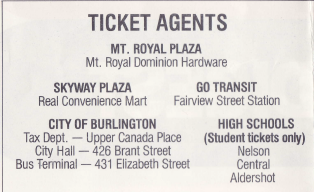 In 1982 there were a number of ticket agents throughout the city. Today there is one bus terminal which the transit people want to close; the public would have to troop over to city hall to buy a ticket. City hall closes at 4:30 pm – never opened on weekends. The 2014 budget does not increase the City’s investment in its transit system. The fulfillment of Burlington’s Official Plan and Strategic Plan require significant additional investment in transit. ROPA (Regional Official Plan Amendments) 38 requires that the transit modal share go from its current 2% to 11% by 2031. This will require an average annual increase in ridership of 10%.
The growth of transit in Burlington requires a long-term plan and funding commitment. The ongoing Transportation Master Plan is an opportunity to develop a long-term transit plan, however, we have been advised by Transportation Department staff that the Transportation Master Plan will not do this. Since the termination of the Transit Master Plan in January 2012, the City has lacked any long-term transit plan.
The budget according to Bfast, continues to treat transit in isolation to the other parts of the City’s transportation system (roads, parking, and active transportation). The majority of the capital budget is for roads, (increasing in 2014 to 54% from 51% in 2013), while transit’s small share of the capital and current budgets does not even get shown in the budget pie-charts.
During the 2013 budget deliberations Bfast we recommended the City look at traffic demand management (TDM) as a means of reducing the very costly widening of roads and intersections in the 10 year capital budget. In the case of the Appleby/Harvester EA, we have been told by the project engineer that TDM was not being looked at or considered.
There are some budget items that reflect the City’s low priority for its transit system.
We note that the funds approved in the 2013 capital budget for transit priority measures ($100,000 for 2014) have been quietly removed from the 2014 budget. Transit priority measures should be part of the Transportation Master Plan and the current Appleby/Harvester intersection plan, as such measures will reduce the car traffic and forego the need for expensive road widening.
Bus Cleaning: It is not clear what is being proposed or if more or less money is required. Bfast fears that that the City may be considering a lower standard of cleaning for the buses. This would be unfair to both drivers and passengers, and sends a wrong message to current and potential transit users. However, Bfast does support the proposal to have the cleaning done by city staff rather than by external contract provided bus cleaning is not compromised.
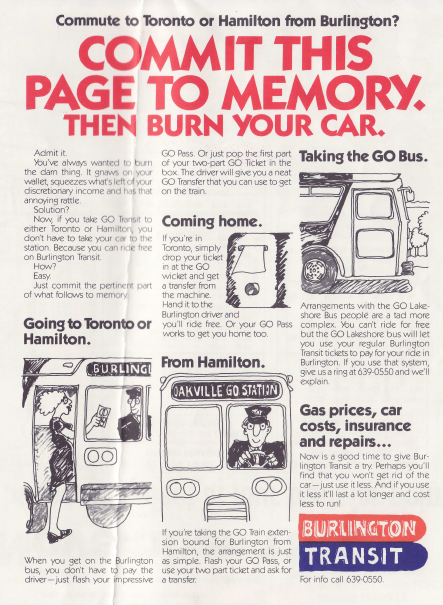 There was a time when the car did not rule and the transit department saw bus service as something that was vital. The marketing people certainly took a different approach. Imagine something like this coming out of the transit department today? Back-end loading of transit in 10-year capital budget. Bfast points out that 75% of bus purchase expenditures occur in 2018-2023 and only 25% occur in 2014-2017. Similarly, a large proportion of bus stop location upgrades and bus shelter expenditures occur in 2018-2023.
To be fair, the city has said it will be doing a total revision of the current capital budget –so anything in that budget beyond this year has to be seen as something that will be getting a very close look. Bfast might want to begin developing its own long term capital plan and prepare to take that to the city.
It appears that the City is planning to close the Downtown Terminal on John Street which Bfast describes an important place of shelter, information, tickets, and washrooms for passengers and drivers. While not a major budget item, the Downtown Terminal is very important to transit users and for the development of a walkable, liveable downtown. Ward 2 councillor Marianne Meed Ward has said she will be speaking very strongly for the retention of the John Street terminal.
Bfast argues that city council has not yet seen a detailed business case for the closing of the terminal downtown and more significantly, neither the general public nor transit users have yet seen a business case for the closing of the terminal. Bfast adds to that the Official Plan process that is holding meetings on potential mobility hubs with the downtown as one of four such mobility hubs. One of the fundamental parts of a mobility hub as defined by the City’s Official Plan process and Metrolinx is that they contain a transit terminal. Further, the Master Transportation Plans is integrating all modes of transportation including transit and at this point we do not know how that plan will deal with transit and the downtown terminal.
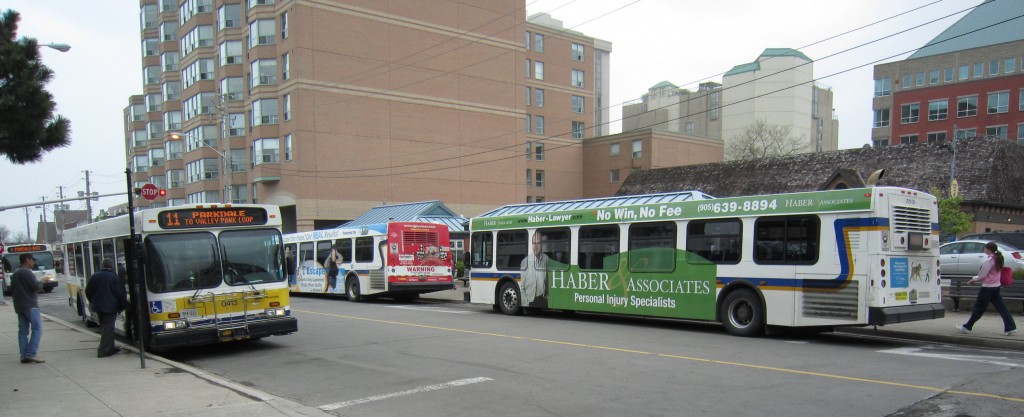 If there was ever a place to locate a transit terminal – that would be John Street where the only terminal in the city is now located. Transit department is recommending it be removed and tickets sold at city hall. Ward 2 Councillor Marianne Meed Ward isn’t buying that business case Bfast suggests this Council is not in a position to determine whether a downtown transit terminal may indeed be a necessary part of an effective transit system that can grow and serve the public effectively in the long run. Any decision to close the downtown terminal now to obtain efficiencies which translate to only $16,000 annually might create long term problems and cost the City far more if the City then has to re-introduce a terminal in the downtown. Bfast is recommending that the future of the downtown terminal be deferred until the Council is more clear on the direction of the Mobility Hub concept re the downtown and the Master Transportation Plan ideas re transit in the downtown. Further, Council needs to direct staff to consult with transit users and the public regarding a possible closing of the terminal.
In their remarks to the committee hearing budget delegations Bfast points out that the 2014 capital budget does include a major investment ($3.4M) in street-scaping in the area of the Downtown Terminal. Surely, this is an opportunity to redevelop the present “kiosk” into a first-rate terminal facility.
There are parts of the transit portion of the budget that confuse Doug Brown, part of the Bfast committee. Referring to a part of the budget about Restoring Transit Services, Brown says “it is unclear exactly what is meant by the item, we haven’t seen the separate report referred to in the Budget document. It would be logical to assume that the Restore Transit Services item comes from the lost capital revenue from changing the federal gas tax funding from a 70-30 split to 80-20. ($500,000 for two years gives $1,000,000). This shouldn’t be regarded as an additional funding option since the funding is already there, just diverted to roads.
Bfast believes Burlington Transit needs to put money into new, (replacement and additional), buses, more shelters, real-time schedule information online and at bus stops, and, more marketing.
When Burlington created its first really relevant Strategic Plan it had no idea how readily the citizens would take to the document. There are very few delegations made that don’t refer to the document. Bfast puts a firm grip on the making Burlington “a walkable, liveable community”. Brown points out that this view has been reinforced by some thoughtful presentations at the bat the Mayor’s Inspire Series where Christopher Hume and Gil Penalosa spoke. Brown wants to see at least some of the ideas that were brought to the city adopted. If we aren’t going to pay any attention to the experts we bring to Burlington to talk to us – then why bother bringing them?, asks Brown.
Dan Burden, an urban planning expert, was engaged by the City to “set the tone” for the Transportation Master Plan. Burden recommended the City create narrower streets to create street life and make the streets safer and more useable by pedestrians and cyclists.
However, the 2014 Budget includes very large expenditures for widening the roads and intersections ($21M for Walkers Line & North Service road and $23M 10 yr. total for Harvester – Appleby to Guelph Line) while, transit, sidewalks, and safe cycling facilities have been underfunded.
 Doug Brown, chair of Bfast, wants to see a bus schedule with routes that work for people and not the current bus route set up in place. It doesn’t work claims Brown. Susan Lewis, who does not drive looks on. There are places she just cannot get to in the city because transit doesn’t work – at least not for her. Brown makes a point that many make on the budget review process Burlington has in place. “Public input on the Budget has again come at the 11th hour, when large changes to the budget are not possible. We encourage the City to provide their citizens with a much earlier opportunity to help shape the budget in the future.”
Doug Brown is chair of Bfast. He brings degrees in science and engineering to the volunteer work he does. What boggles a lot of people is that Brown isn`t used by the city as a significant source of information and advice. Doug Brown was riding the bus in Burlington before the current Direct of Transit Mike Spicer even got to this city.
The city has an asset it needs to consider leveraging.
There is a lot more to be written about transit and how people like Susan Lewis get around in the city. Let’s see what city council decides to do with the current transit budget.

 By Staff By Staff
February 20, 2014
BURLINGTON, ON.
We can’t win. Week upon week of snow and now we are to get rain and need to watch for flooding! The city has 12 crews clearing snow and ice from catch basins and culverts throughout the city,” said Cathy Robertson, director of the roads and parks maintenance department. “They will keep at it until later this evening and then continue again on Thursday.”
Temperatures are predicted to rise to 4 C. How many days ago was it when there were snow plows driving up and down our streets putting piles of snow at the end of our driveways
Residents are asked to assist by checking and clearing storm drains and culverts in front of their homes if they are able to do so.
If there is flooding please call 905-333-6166 between 8:45 a.m. and 4:30 p.m. or email rpm@burlington.ca.

 By Staff By Staff
February 19, 2014
BURLINGTON, ON
We won’t know until next Spring if these four are true heavy hitters but the Burlington Bandits who have been on a bit of a roll when it comes to signing up players announced that Jordan Boston, Kyle Bolton, Dylan Perego and Evan DiMichele have been signed to the team for the 23014 season.
 Part of the 2014 lineup for the Burlington Bandits: from left to right Kyle Bolton, Dylan Perego, Evan DiMichele and Jordan Boston Boston comes into his first season with the Bandits after a collegiate career with Alcorn State in Alabama. The 6’2”, 205 pound player from Brampton, ON previously played with the Ontario Blue Jays and Team Ontario in the Premier Baseball League on Ontario. Most impressive was his time with the prestigious Junior National Team in 2009 and 2010.
Bolton, a right-handed pitcher from Burlington, ON is returning for his fourth season with the Bandits. In 2013 with the Bandits, Bolton had an ERA of 8.62 in 14 games.
Perego, a right-handed pitcher from Waterdown, ON will join the Bandits for his second season. In his debut season with the Bandits in 2013, Perego had an ERA of 4.54 in 14 games.
DiMichele, also a right-handed pitcher from Oakville, ON returns for his second season with the Bandits after joining the team in 2013. Last season, DiMichele had an ERA of 5.79 in 16 games.
The Burlington Bandits season opens on the road when they visit Toronto on May 4th.
The club will then return home the following weekend for their home opener on Saturday, May 10th versus the Hamilton Cardinals; game time 1:00pm.
Season and individual tickets are on sale now! For more information about these signings or how to purchase tickets, contact the Bandits at info@burlingtonbandits.com or 905-634-3725.

 By Staff By Staff
February 18, 2014
BURLINGTON, ON.
If you were around the John Street bus terminal on Tuesday you might have been approached by people asking you to sign a petition asking the provincial government to take their announced plan to raise the minimum wage from $10.25 to $11.00 an hour in June.
The Campaign to Raise the Minimum Wage (CRMW) points out that an increase of 75 cents an hour will not get minimum wage earners out of poverty.
The private sector maintains that $14 an hour will cripple them and it is certainly a significant increase – but we can’t pay people $11 an hour and expect them to live a decent life. Food banks, and landlord tenant issues are part of the $11 an hour world.
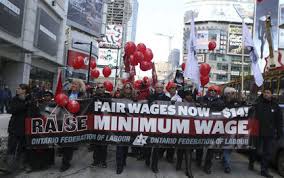 There are a lot of people struggling to get by on $11 an hour. The push now for more is much stronger than it has been in the past. Those on minimum wage would like to see the province come up with a schedule that gets the rate from $11 in June to $14 over a 24 to 30 month time frame and at that point link the minimum wage rate the Consumer Price Index.
Changes like this get made when there is political pressure. Ontario’s current premier has said $11 is a done deal – can she be pushed further? Will NDP leader Andrea Horwath bring her political clout to bear and get something decent in place.
If there is enough political pressure it can happen.
Start making phone calls – forget the Progressive Conservatives – they are talking up a Million Jobs policy – with many at $11 an hour. Horwath and the NDP is the pressure point.

 By Pepper Parr By Pepper Parr
February 19, 2014
BURLINGTON, ON.
After a CLOSED SESSION of city council Tuesday evening the city puts out a press release saying IKEA Canada has announced the retailer will not relocate to a proposed site at Walker’s Line and the North Service Road but will stay at its Plains Road East location.
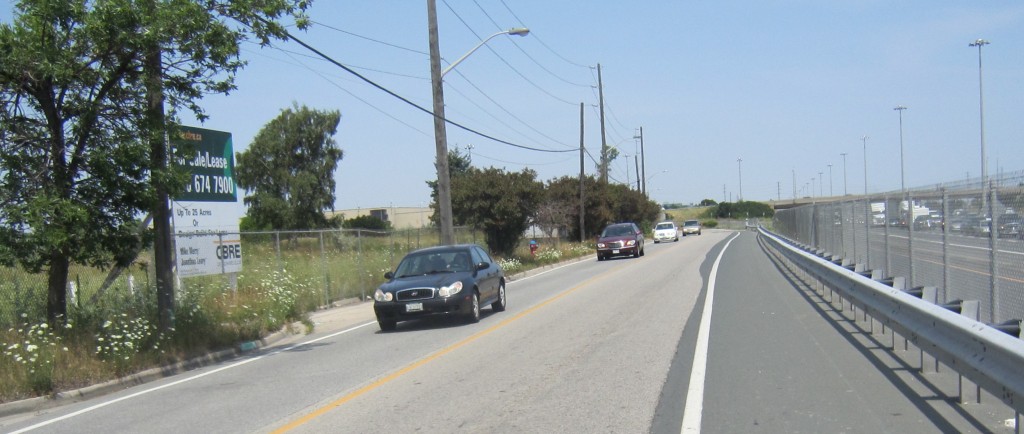 The property to the left was to be home for a newer and bigger IKEA with great visibility along the QEW. More parking space, more retail space and more head office space. Not on this location. “We were planning to relocate the existing store,” said Paul Ekelschot, properties manager with IKEA. “However, IKEA has assessed that the site is not the best solution for our needs and that we will continue to provide our valued customers with a great shopping experience in the current location at this time.”
Came to the conclusion that it couldn’t be made to work is a better explanation.
 This property is still for sale. With IKEA out of the picture the Hopewell people will be looking fr a buyer. Gonna take a while. City hall says: “IKEA began working with the City of Burlington and other agencies, including Conservation Halton, Halton Region and the Ministry of Transportation, in 2011 to start the process of rezoning and approvals linked with relocation to the North Service Road location.”
They add that: “City staff worked with staff from the provincial Ministry of Transportation to determine the necessary road improvements required to accommodate the city’s growth projections and to ensure the continued safe and efficient operation of the Walker’s Line/QEW interchange.”
They don’t say how much the city spent on trying to make this opportunity work.
“While much hard work has gone into preparing a site for the relocation, that work is not in vain,” said Scott Stewart, the city’s general manager of development and infrastructure. “We have created a solid scenario for future economic development at Walker’s Line and the North Service Road.”
Stewart’s got to say something to account for the time spent on this project. The reality of the site was pretty clear to anyone who drove along the North Service Road – it isn’t anywhere near wide enough to accommodate the traffic IKEA would create.
The site has some benefits but before much gets done on the North Service Road between Guelph and Appleby – a lot of hard thinking has to be done. That portion of the city was given the slick marketing moniker of our “Prosperity Corridor”
Meanwhile, IKEA says that it’s business as usual for shoppers in Burlington where the Plains Road store opened in 1991.
“We are grateful to the City of Burlington and other government agencies for trying to make this work,” Ekelschot said. “IKEA has a good working relationship with the City of Burlington. We are a proud member of the Burlington business community and our plan is to remain in Burlington.”
 Those Swiss meatballs are still on the menu – getting a table on a Saturday morning was the challenge. IKEA needed a move – just didn’t have the right location. Would Mr. Ekelschot perhaps accept an invoice from the city to cover part of the staff time put in on this project? The Planning department along with the rest of the senior people at Infrastructure and development might have been wiser to have had a frank but cordial face to face with the IKEA people back in 2011 and said – guys – this isn’t going to work.
Wonder how this news will fly at the Committee of the While next week when council and city staff meet to discuss the future of the Economic Development Corporation.
Ward 1 Councillor Rick Craven must have felt quite a bit better last night when he drove home from the council meeting – his biggest business was not going to leave town after all.
Background links:
Now we know why IKEA was on the agenda,

 By Staff By Staff
February 19th, 2014
BURLINGTON, ON.
IKEA gives up on move to North Service Road – announces it will remain in Aldershot.
More to follow.

 By Pepper Parr By Pepper Parr
February 19, 2014
BURLINGTON, ON.
You can`t fault Councillor Jack Dennison for trying – and try he does. During a Standing Committee last week when discussions on the capital projects the city will take on in 2014 as they spend the $67 million plus that council is expected to approve Tuesday evening, Dennison felt there were opportunities that were being missed and wanted the city to consider selling the Tyandaga Golf course property.
 Ward 4 Councillor Jack Dennison always has an eye open for an economic opportunity – sees a great one for the city: sell the golf course. “This isn’t a business we should be in” Dennison commented, echoing remarks city manager Jeff Fielding had made more than a year ago. While Tyandaga is currently running at a bit of a profit that was not the case a couple of years ago. At that time the golf course juggled its business model and tightened up its management practices and the profit and loss statement began to look better.
Dennison just doesn`t think the city should be in the golf course business and pointed to the “40 golf courses” in the surrounding communities – that number might be a stretch, but Burlington certainly has its share of golf clubs that are a 15 minute drive from the downtown core. Should the city be in a losing business when there are plenty of very good private golf clubs in the community?
 Ward 4 Councillor Jack Dennison sees 200 homes on the Tyandaga golf course property and thinks the Catholic Diocese property that front on Brant Street could be made a part of the project as well. Dennison saw the 110 acre Tyandaga property as prime residential development land and talked of being able to get something between $12 and $18 million for the land alone. He added to that the immense development charges that would accrue to the city and then the tax assessment which he pegged at $200 million.
Dennison told his colleagues that the property had 33 acres of land that could be developed and because of the location he saw at least six houses on each acre getting pretty close to 200 homes on a prime site that would have 76 acres of parkland.
Before we knew it Dennison had $1.6 million in additional tax revenue in the city’s coffers.
 The golf course wants to spend $150,000 this year on upgrading parts of the golf course – Dennison wanted to defer that spending while the city took a closer look at the property and the opportunity he felt it offered. The golf course wants to spend $150,000 this year on upgrading parts of the golf course – Dennison wanted to defer that spending while the city took a closer look at the property and the opportunity he felt it offered.
The rest of Council wasn’t as gung-ho as Dennison. They Mayor said it looked like a “cash grab” to him but didn’t explain what was wrong with wringing cash out of an underperforming asset.
The rest of Council didn’t get very excited either. Ward 1 Councillor Rick Craven was delayed in getting to the Standing Committee meeting and missed a discussion that would have taken a major public recreational service off his plate.
Councillor Sharman took the high road and said the selling of the golf course had to be looked at in a “broader context” but didn’t elaborate on what that meant other than to say that the city was “not ready for the discussion”.
Councillor Meed Ward piped in with her view that adding residential assessment isn’t always a good deal for the city. “For every dollar of tax revenue we pull from residential properties we end up, over time, spending a $1.40 Dennison came back with “that argument doesn’t really hold all that well”.
Council needed some input on just what the planned spending on the golf course was for and called Director of Parks and Recreation Chris Glenn to the podium. Odd as it may sound Glenn wasn’t able to say just how many golf courses there were in Burlington, nor could a member of his staff come up with a solid number.
 Were anyone to ask a privately operated golf course what their competition was you would expect them to tell you exactly how many competitors they had and be able to tell you which were their closest competitors in terms of course usage and revenue. The mindset of the private sector is a lot different from the mindset of the public sector where the renewal of an asset is based on a chart or a schedule that dictates when an asset has to be renewed. The private sector operator would wring every possible nickel out of a piece of equipment. Any expenditure comes out of the bottom line which tends to be the owners pockets. Were anyone to ask a privately operated golf course what their competition was you would expect them to tell you exactly how many competitors they had and be able to tell you which were their closest competitors in terms of course usage and revenue. The mindset of the private sector is a lot different from the mindset of the public sector where the renewal of an asset is based on a chart or a schedule that dictates when an asset has to be renewed. The private sector operator would wring every possible nickel out of a piece of equipment. Any expenditure comes out of the bottom line which tends to be the owners pockets.
Glenn explained what the $150,000 was going to be used for – and added that it wasn’t really a capital expenditure from the city’s point of view – the expenditures were going to come out of reserves the golf course had in place.
For Dennison it was an opportunity that was being missed; he wanted to see the asset being used in a much different way. He didn’t manage to convince his colleagues to go along with him – the motion to defer the item was lost on a 4-2 vote. But Dennison did manage to plant a seed – the city manager is way ahead of him on this one. When city council decides what businesses it wants to be in – the golf course business is not likely to be one of them.
Another question is: will Jack Dennison be on Council to see this kind of development take place.
At the Tuesday evening Council meeting the Capital budget was approved for 2014. There are loads of items in the longer term capital budget that will be getting a much different look during the year. City hall will begin the process of totally recasting capital expenditures as it reorients itself to its new financial reality. Among the projects in that capital budget that will be getting a closer look are the railway underpasses on Mainway and Burloak – neither is going anywhere in 2014 – both will be getting a closer look as the longer term capital budget gets its remake.
On the books for the 2015 to 2023 capital spending is a massive $494,012,195 in capital spending. City manager Jeff Fielding looked at the cookie jar and knew pretty quickly that the number wasn’t possible – thus the decision to totally recast what we want to do, what we have to do and what we can do in the way of capital spending for the next 15 years.
 Lori Jivan, on the right, Acting coordinator budget and policy with the city explains the 2014 budget at a public meeting. With the capital budget of $67,973,902 nailed down – let’s look at where the money is going to come from: Lori Jivan, Acting coordinator budget and policy explains:
External other: These are monies the city gets from other place, could be the provincial government, the Region or some other municipality we are doing a joint project with. If Tremaine Road was having work done on it – because it is our border with Oakville they might be paying part of the cost. We pick up $10,089,000 from this source.
Debt: We sometimes decide to borrow money to pay for a capital project. This year the city projects they will borrow $6,903,000
Cash from the current budget: This is tax revenue – money the city collects as taxes. A portion of the tax money gets pushed into the Capital account. For 2014 they are moving $16,684,000 into capital expenditures
IRRF – this is the Infrastructure Recover Fund which amount to $2.000.000 the city gets from Burlington Hydro. It comes to the city from Hydro as a dividend which the city places in the Infrastructure Recovery account. $2,000,000
SCD: Special Circumstances Debt. This is an estimate of the amount of debt the city will have to take on for special project – one time situations that might get taken on. The Performing Arts Centre is an example of a one time Special debt.
FGT: Federal Gas Tax. The portion of the federal gas tax that the city receives. For 2014 that is set at $4.774,000
Provincial Gas Tax PGT: The portion of the provincial gas tax the city receives. For 2014 that is set as $850,000.
Reserve funds will be used with $20,648,000 coming from the development charge reserve and $5,027,00 coming from what the city calls “other”.

 By Pepper Parr By Pepper Parr
February 19, 2014
BURLINGTON, ON.
There was just the one delegation at city council last night – had to do with the re-naming of Southampton Boulevard to Constable Henshaw Boulevard
Ben Carman asked Council to name some other city asset after the long serving police officer who died in 2010 of natural causes while on duty.
Councillor Lancaster took exception to some of the comments made by Carman and asked if she had not call the Carman residence on three occasions. She had indeed replied Ben Carman – the calls came after a recommendation had been made by the Standing committee. Carman had expected to be able to speak to his council member before the recommendation was made. He isn’t the first person to complain about the level of access to the ward 6 member of council.
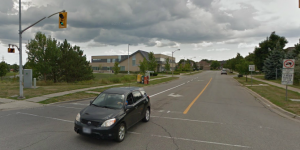 What was Southampton will become Constable Henshaw Boulevard. Council didn’t get to hear why the residents really didn’t want the name change.
Lancaster, who has had problems with constituents groups in the past, appears to be upping her game now that we are in an election year and stressing that she does get back to people. It should be noted though that Lancaster has yet to file her nomination papers, although she has said publicly that she intends to run again for the ward 6 seat which includes the Headon Forest community that Southampton.
It was difficult to fully understand what the opposition within the Headon Forest community was with the renaming of the street. Ben Carman and his wife Susan talked after the council meeting about the difficulty they and their neighbours have had with the administration at the Southampton police station.
There was a time said Carman when the relationship with the police detachment was very good but it has deteriorated. By way of example he commented on the use of heavy equipment to move snow around the police parking lot – at 11:30 at night. When calls were made to complain about the noise Carman felt he was treated poorly and being told that the police can do what they want and don’t have to comply with noise bylaws didn’t do much for his view of the way police and community should be working together.
 It would appear that the Headon Forest community haven’t taken to the idea of renaming Southampton after a police officer because the relationship with the detachment isn’t all that good to begin with. Sounds as if there is a little too much arrogance within the detachment. It would appear that the Headon Forest community haven’t taken to the idea of renaming Southampton after a police officer because the relationship with the detachment isn’t all that good to begin with. Sounds as if there is a little too much arrogance within the detachment.
During his delegation Carman made no comment on the apparent friction between the police detachment that is on Southampton and the community. But that appears to be what the problem really is. Lancaster of course knew nothing of this – because she didn’t succeed in getting back to the resident before the discussion on the issue took place at the Standing committee.
Councillor Craven, who represents the city on the Police Services Board might want to give Ben and Susan Carman a call and learn a little bit more about a community that appears to have a problem with its local police.
Lancaster will have a problem with Craven crossing into her ward – tough – this is an issue that needs attention.
Background links:
Residents don’t support street name change.
Council goes with what the police association members want.
Lancaster and communications skills.

 By Pepper Parr By Pepper Parr
February 19th, 2014
BURLINGTON, ON.
Council meetings in Burlington tend to be quickies – the tough slugging gets done for the most part at the Standing Committee level – but from time to time there are some news gems to be picked up.
At the Tuesday evening council meeting there was a single delegation and a last-minute item that got pushed onto the agenda.
The last-minute item was a need to go into a CLOSED SESSION – which usually happens when there is either a property matter or a human resources issue.
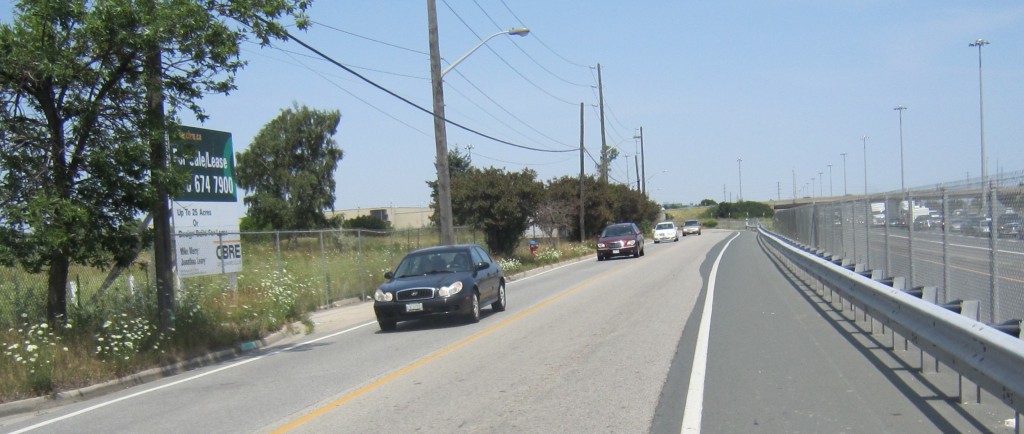 A prime concern has always been the width of the North Service Road and how traffic to the new IKEA location would be managed. This time it was a property matter – which in itself is not unusual but when the Mayor said the words IKEA – ears perk up. What could there be that is a property related matter on the IKEA project – which if you will recall is the struggling effort to move IKEA from their current Burlington operation out in Aldershot to a new location on the North Service Road between Walkers Line and Guelph Line.
There was every indication that the property issues had been resolved and that the Ministry of Transportation wasn’t giving an inch on the work that had to be done to the Walkers Line intersection that needs major work if traffic is going to get to the new IKEA location.
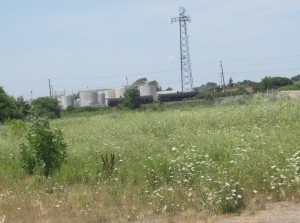 The property IKEA has chosen for their new location is quite deep but the north side of it isn’t all that pretty. A rail line runs along the northern edge. Could the problem be something related to Conservation Halton and the problems with the creek that runs along the eastern side of the property?
Or has someone finally realized there is going to be a major problem with traffic on the North Service road unless major changes are made to the width of that road?
Whatever it is – the problems are inside one of the three in binders General Manager Scott Stewart took to the horseshoe as the media left the room. Stewart has been managing this file since its inception – and it has begun to get messy.
IKEA tends to be very tight-lipped when it comes to talking about his project which hasn’t been as smooth as one would expect from a major multi national corporation.
IKEA decided some time ago that they needed to move out of Aldershot and settled on the North Service Road location because it was available and it would give them the QEW exposure that IKEA tends to want.
Getting the matter before council on basically no notice and not waiting until the next Standing Committee meeting suggests there is something up. Quite what – we don’t know.
Let’s see what a little digging can do.
Background links:
IKEA move gets tangled up in the paperwork.
IKEA move takes longer than expected.
IKEA announces a move out of Aldershot.

 By Ray Rivers By Ray Rivers
February 18, 2014
BURLINGTON, ON.
“The single most important thing the government can do to secure Ontario’s prosperity is to eliminate the deficit.” This statement appears at least three times in the 2013 budget document, as if to leave no uncertainty that Ontario’s ballooning debt is front and center of all policy. That debt now has risen to match that of the federal government as a percentage of gross domestic product (GDP) – approaching 40 percent.
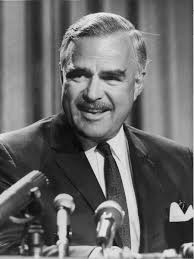 John Robarts – one of the best Premiers the province ever had: knew how to balance a budget. I grew up observing John Robarts, nicknamed ‘the Chairman of the Board’ for his commanding leadership of Ontario. He presided over unprecedented economic development, with up to 8% growth rates during the 1960’s. He gave us our single-payer health insurance, modernized the public service, introduced bilingualism and education reform and was known for his balanced budgets.
His successor, Bill Davis, on the other hand, governed the province form 1971 to 1985 but never once balanced a budget. David Peterson eked out a small surplus in his last year in office and we all know that Bob Rae’s NDP never even came close. For all his big talk, Mike (the knife) Harris managed only four balanced budgets before quitting politics, leaving his next inevitable deficit for Ernie Eves to announce. Then Dalton McGuinty’s Liberals registered three balanced budgets in a row during their first eight years in office.
 Bill Davis had problems learning how to balance a budget; never really did learn. In fact, if we add up the budgetary performance of all governments over the last forty-two years ago, going back to when Bill Davis became Premier, we’d find that the Liberals and Progressive Conservatives delivered exactly the same number of balanced budgets – four a piece. And, the Tories held power for five more years than the Liberals over that time frame. Thus, this myth that Conservatives are somehow better at managing the deficit is pure and utter rubbish. This is also true for the federal political parties.
John Robarts benefited from a truly progressive income tax system where the wealthy paid their fair share, and the middle class prospered. Mike Harris, by contrast, made huge cuts in income taxes and paid for them by slashing public programs – primarily welfare, health care, education and municipal services. Given the magnitude of Harris’ austerity program, he should have been able to balance all of his budgets, had he just not cut income taxes as he did. As the current federal finance minister is fond of saying – there is no free lunch.
 Dalton McGuinty balanced some budgets – but budgets weren’t his downfall – the gas plant fiasco did him in. McGuinty raised taxes modestly on coming to office, introducing the Health (insurance) Premium. But then he further cut corporate and personal taxes, ironically, at a time when the economy most needed more tax revenue to deal with the consequences of the 2008 global meltdown. As a result the provincial debt which has nearly doubled since 2004 is now a priority for Premier Wynne.
 Bob Rae couldn’t catch a break anywhere and had the misfortune of getting hit by an economy no one was able to manage. The lack of any experience running a government didn’t help. Balancing a budget requires tough choices, compromise and determination. Bill Davis had the good fortune to inherit a well-run and funded government, yet failed to keep his expenses in balance over his fourteen year run. Mike Harris squandered the benefits of his austerity measures and Bob Rae, stuck with Ontario’s worst recession since the nineteen-thirties, couldn’t get a break.
McGuinty inherited Harris’ tax regime yet still pulled out three surpluses, even as Ontario became a have-not province in the federation. Unlike Harris, however, he actually expanded the effectiveness of public service. Health care waiting times fell from being the longest in Canada to the shortest; high school graduation rates jumped from 68% (2003) to 83% (2011) ; school test scores rose to among the highest in the country; and poverty levels dropped.
High public debt limits the ability of a government to respond to circumstances, such as the economic collapses in 1990 or 2008, with the wherewithal to effect a swift recovery. And paying interest on that debt is money which cannot be used for some other economic purpose. John Robarts followed the Keynesian economic model, which asserts that debt be paid down in good economic times – but Keynes became a pariah in the eighties. So today both Ontario and the federal government are running debt levels at over a third of our GDP – levels which are high, if not dangerously high for the eventual rise in interest rates.
 Mike Harris balanced some of his budgets – but was known more for the significant damage done to the province’s education system and reducing the wrong taxes for the wrong reasons. To address this, Ontario could go back to the austerity of the ‘Mike the knife’ days, closing hospitals and laying off nurses; increasing class room sizes and laying off teachers; selling off crown corporations and assets; and deferring essential infrastructure like bridges, highways and public transit. We recall stories of classroom wars, cardiac patients dying in hospital hallways awaiting critical surgery, and tires flying off trucks on our highways during the good old Harris days.
Alternatively we could just let the debt continue to rise until it becomes difficult and costly to borrow any more, blindly mimicking what we witnessed with the Greek economy last year. Or, we could go back to paying our way as we go. We could bring back the kinds of taxation policies which would grow the middle class – the ones which enabled John Robarts to fund Ontario’s high growth in the sixties, without the need to run up deficits and the debt.
 Ray Rivers writes weekly on both federal and provincial politics, applying his more than 25 years as a federal bureaucrat to his thinking. Rivers was a candidate for provincial office in Burlington where he ran against Cam Jackson in 1995, the year Mike Harris and the Common Sense Revolution swept the province. He developed the current policy process for the Ontario Liberal Party. Ray Rivers writes weekly on both federal and provincial politics, applying his more than 25 years as a federal bureaucrat to his thinking. Rivers was a candidate for provincial office in Burlington where he ran against Cam Jackson in 1995, the year Mike Harris and the Common Sense Revolution swept the province. He developed the current policy process for the Ontario Liberal Party.
Background links:
2013 Ontario Budget John Robarts Bill Davis McGuinty and Harris Education in Ontario
Finance Minister’s Address Ontario’s Fiscal History Public Debt Canadian Public Debt

 By Pepper Parr By Pepper Parr
February 17, 2014
BURLINGTON, ON.
Marianne Meed Ward set the scene when she explained as Chair of the Community and Corporate Services Standing Committee that they were there to “listen today”.
This was the day council members were going to hear delegations. There were 12 of them and at ten minutes each we knew we were going to be there for a while. Several were exceptionally good – all added to the process in a measurable, meaningful way and at the same time gave us an insight as to how your council works on your behalf.
Culture, economic development, caring for the community and transit got coverage. In this series we will run three articles and focus on what happened and what it all means for the economic and social health of the city.
 Culture was clearly the biggest concern: with delegations from the Art Centre, who had a very spiffy presentation, Sound of Music, who finally shared their audited financial statements, Heritage Burlington who came up with a new logo that cost less than $2000, which made Councillor Dennison smile. And then the decision as to whether or not to hire a full-time Cultural Manager to implement the Cultural Action Plan council had already approved. Culture was clearly the biggest concern: with delegations from the Art Centre, who had a very spiffy presentation, Sound of Music, who finally shared their audited financial statements, Heritage Burlington who came up with a new logo that cost less than $2000, which made Councillor Dennison smile. And then the decision as to whether or not to hire a full-time Cultural Manager to implement the Cultural Action Plan council had already approved.
We will focus on culture in this piece and follow-up with two additional pieces on Economic Development and services to the community.
 Great crowds, great weather, great music – Burlington’s Sound of Music Festival – a standard since before 1996 The Sound of Music wants $44,000 from the city in addition to the $54,101,00 that is already in their base budget. Council appears ready to go along with getting those additional dollars. Dave Miller, Sound of Music Executive Director said in his delegation that he wouldn’t come back looking for money for five years if the city agreed to put the additional funds into the base budget. That`s the kind of deal this council just might take him up on. Miller has been at this Council almost since they were sworn in. He has been relentless.
While the event is probably the largest that takes place on the waterfront, Dave Miller didn’t get much in the way of respect from this city council. In this his third year before council seeking financial support the SOM hasn’t managed to convey the size of the economic impact the event has on the city. Council can’t see beyond the more than half a million dollars they have on their balance sheet. Miller hasn’t succeeded in convincing this council that the funds are vital – all it takes is one year of bad weather and the SOM would take a huge hit.
 They come in droves for the biggest free music festival in the province. Miller pushed all the usual keys: the excellent ratings from visitors, the quality of the performances, the demographics, the accessibility of the event, the awards they continually get; the constant improvements they make to the environment with their clean up practices and that the SOM is a fun safe event. He trots out cute pictures of kids and talks up what the event does to Burlington’s profile and the support the event provides for emerging bands. He was talking to people who are deaf to the upside of what the SOM does for the city. Council sees all that money on the balance sheet and drools.
Miller adds that the SOM is the driving force for more than $6 million in economic activity with 45,000 of the attendance defined as new visitors to the event; 40% are from outside Burlington and according to Miller 80% of the people attending have been to the event before. Something in those numbers doesn’t quite add up – but that’s not the point. Try taking it away: What would happen if the SOM folk decided that they have been at it for many years and need to take a break for a year and re-think what they are doing and how they do it? This council would howl.
 What Miller hasn’t managed to do is make the city his partner. The SOM doesn’t have a champion, a true spear carrier on council. An organization with 800 volunteers, a very strong balance sheet and a solid record of achievement deserves the nomination they got from the Chamber of Commerce as a best business operation. What Miller hasn’t managed to do is make the city his partner. The SOM doesn’t have a champion, a true spear carrier on council. An organization with 800 volunteers, a very strong balance sheet and a solid record of achievement deserves the nomination they got from the Chamber of Commerce as a best business operation.
The SOM financial statements point to;
$35,900 + that they pay the police security
$13,946 + they pay the city for permits
$22,381 they pay the Parks and Road Maintenance for material, equipment and repairs to the park grounds.
The SOM pays the Performing Arts Centre $8,300 + for the use of their space.
The event results in $8,000 in parking revenue plus a significant boost in parking tickets.
SOM says they add $15,000 to transit revenue.
The Sound of Music has a strong story on the performance side as well. In 1997 there were 47 performances – in 2013 there were 100. Attendance in 1997 was 90,000 that number rose to 215,000 in 2013
The city`s financial contribution rose as well; from$25,000 in 1997 to $54,000+ in 2013. In terms of what portion of SOM revenue came from the city – that number slid from 13% in 1997 to 4% in 2013.
Miller has been at this since 1996 when he joined as a volunteer and earned the position of Executive Director some time after that. Miller gets paid but doesn’t have a pension. SOM has more than 800 volunteers, many that use their vacations to “do the festival”.
Miller keeps wanting to grow the event – which led to Councillor Lancaster asking last year when was “enough enough?” There has been some reluctance to see the event grow to anything bigger than it is which suggests Miller and his organization have some relationship building to do.
Miller needs the funding from the city to qualify for funding from other levels of government. Governments ted to want everyone to be in the tub at the same time, sharing the same bar of soap.
 The Sound of Music Festival parade gets the annual event off to a strong start. Sound of Music for 2014 will begin June 7 with the parade that will have a slightly different route and then moves into their usual four-day event that brings great music to the city and hundreds of thousands of people to the waterfront – and loads of revenue for almost everyone in the city.
And yet the Sound of Music can`t get a miserable 4% of their budget from the city. Not coming up with the cash is sort of like throwing the baby out with the bath water – isn’t it?

 By Pepper Parr By Pepper Parr
February 15, 2014
BURLINGTON, ON.
It is surprising how little we hear from Council members on the issue of improving the dangerously low economic growth of the city.
 The BEDC has a formula they use to go from the first hint, tip, request – whatever they get to track the opportunity. Is this a viable model? Are there better models out there? This one suggests we wait for people to call on us – do we ever go out and attempt to convince people to come to us? That’s how Hamilton took International Harvester off our plate and ate our lunch. Economic development for Burlington is done by a standalone unit that is not part of the city hall operation. The Burlington Economic Development Corporation is a unit that is subsidized by the city and charged with attracting new business to Burlington and retaining the business we already have.
Burlington is now at a point where its financial growth is not going to come from the residential housing sector. We are very close to build out – there are but two large developments left to get done, one in the east along Tremaine Road and the other in the west known as Eagle heights – after that it is infill and small pocket developments.
The city has a lot of land that is designated and zoned “employment lands”. The owners of much of that land would prefer to see it used for residential development where the profits are much higher. Residential development will attract new families but also add a significant burden to the city’s cost structure.
The industrial commercial sector not only returns higher tax dollars to the city but creates jobs as well. Those jobs attract younger people and for a city that has the largest growth in the seniors demographic in the GTA that growth is important.
In 2012 the city’s tax growth in the ICI (Industrial Commercial Institutional) sector was a negative number compared to 2011 and will be the same for the 2013 tax year. The prospects for the next couple of years are not a lot better.
Something had to be done with the BEDC – they just were not producing. Burlington has a great story to tell and we were doing a terrible job of telling our story and attracting new business. We don’t recall a single media release on a new business coming to town from the BEDC. We did get media releases from a few new business operations – Lowes being one.
If the BEDC doesn’t tell its story – then its story doesn’t get told and when anyone goes to the internet and enters Burlington new business – there won’t be much to see.
The organization has taken on a secretive approach – getting information out of them has been very difficult – they are not exactly media friendly. They tend to hunker down and hope that things will just blow over – an attitude and approach that applies to both staff and the directors. We recall two situations where we have asked for comment and were referred to the Executive Director who they later fired.
When the BEDC gets “repurposed” or “reinvented” or whatever they decide to call themselves they need to take on a good dollop of media savviness as well. They need to understand they are a sales organization charged with the responsibility of selling the city as a great place to live and do business. When Burlington was named the best medium-sized city in Canada to live in the BEDC immediately took out a full-page advertisement in a leading business magazine. It was the best they could do.
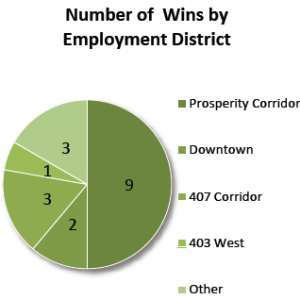 Not much for the downtown core. Are we doing what needs to be done with the QEW Prosperity Corridor?  Is this the type of business Burlington wants? Did we go looking for them or did they call us? The administrative structure of the BEDC from about 2009 through to 2011 required them to raise a large part of their budget which they did with events. The focus often went to creating, marketing and then putting on a series of networking events. BEDC management couldn’t manage to operate on the two fronts and the attraction of new business suffered.
The BEDC kept producing reports which all too often suggested yet another report. Early in the fall the BEDC Board came to the conclusion that the Executive Director was not the man for the job and the two parted ways – but not before a Board member, who should have known better, made statements that added to the size of the separation package the city had to pay out.
The BEDC is now looking for a new Executive Director but can’t start that process until there is a clear, strong governance model in place. That task seems to be taking quite a bit of time and is in the hands of Gerry Smallgange, Burlington Hydro president and Pat Sugrue of Fearmans Pork Inc.; both BEDC board members.. Acting Executive Director Scott Stewart, who is also the General manager for the city of Infrastructure and Development, put it very bluntly when he said: “These gentlemen and the board owe you a report on this topic in April”. The BEDC board owes the city a lot more than a single report.
In the past year Burlington managed to lose one of our historically long operations – International Harvester, that got scooped up by Hamilton.
Some of the data presented to the Standing Committee earlier in the week suggests BEDC has upped their game and they are now doing the job they were put in place to do. Not everyone agrees with that assumption.
 It’s not a bad story – but is the story good enough and can we do better? 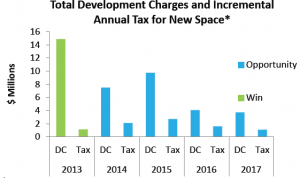 Looks like a lot of “speculation” on those development charges going forward. Stewart, serving as Acting Executive Director since November of last year took the Committee though the data pointing out that 2013 has been a “transition” year for the BEDC. Scott comments:
The governance model is expected to come up with a “completely re-constituted board”. The term for the current board ends at its AGM on May 29th
That base budget Stewart was delegating on was originally submitted in October by the previous and now departed Executive Director. The base budget is now set at $958,000 which includes a reduction of $22,000 that the BEDC was directed to remove.
In addition to the base budget there are three business cases council is being asked to consider for a total of $275,000
What is a bit surprising and disturbing is that the BEDC has had three months and to re-develop their raison d’êtreand craft a governance model – and there is nothing to show yet. This isn’t rocket science; these governance models are done in the private sector every day.
 Turning those opportunities into wins is the challenge.  There are some critical sectors we are not active in. How do we change that? A legitimate question would be – why hasn’t this been done by now and what have you been doing for the past three and a half months? There are three members of Council on the BEDC; the Mayor, Councillors Sharman and Dennison. Earlier in the day the BEDC delegation was heard Councillor Sharman had asked Rishia Burke, who was delegating on behalf of a Community Development Halton initiative, what she did each day. Ms Burke acquitted herself quite well – the same cannot be said for Councillor Sharman if he had been asked what he has done on the BEDC.
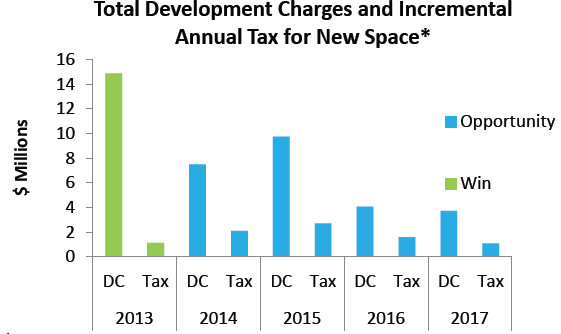 The development Charges are interesting – but there has to be a commitment before those charges get levied. The citizens of the city just don’t hear what that board does; what the wins have been and what the problems are – and there are very clearly serious and significant problems. It appears that the problem has been a lack of both leadership and focus – this Board doesn’t seem to know what it is supposed to be. It is far too large a board and it isn’t clear where the leadership is coming from. For the immediate future the day-to-day operations are being led by a city General manager who spends half a day a week at that office.
 Are the council members on the BEDC the three moneys? As the Acting Executive Director Scott Stewart was the person that spoke for the BEDC at the Standing Committee meeting; not word from the Chair who was in the room and nothing from the council members who sit on that board. Stewart does the best that can be expected under the circumstances he has to work with.
Were those three doing a three monkey act: See you evil, hear no evil, speak no evil? What the public hears is that we have a Prosperity corridor and somebody is interested in some property over there.
Questions were asked at the Standing Committee by ward 2 councilor Marianne Meed Ward who said she had plenty of questions which she had sent to the BEDC board. They were not read out in the open meeting but here they are:
1. What is the result of the marketing funds the city gave the BEDC last year? Any new businesses locate here as a result? Any leads?
2. What is the current staffing, in terms of roles? Is there a full-time person devoted to lead generation/sales?
3. What is the current staffing requirement for events?
4. Could the BEDC get out of events this year (i.e. how many are already booked/paid for; can you release the balance so by 2015 there are no more events)? Which events remain on the books this year?
5. What are the marketing funds for the 2014 budget going towards? What are the measurables – i.e. what is the BEDC expecting in return for this investment? Jobs? Leads? Etc.
6. What’s included in the marketing and investment attraction “employment lands marketing initiatives” line item?
7. How many sales calls are staff expected to generate, leading to how many leads, leading to how many news jobs/business/sq ft in Burlington?
8. Where does the money in the innovate Burlington line item come from?
 9. Salaries saw an increase in 4.18%. Can you advise why? More staff? What’s the budgeted raise? At the city, the compensation amount is set at 1%. How much would your budget be reduced by if you also kept HR to 1%? 9. Salaries saw an increase in 4.18%. Can you advise why? More staff? What’s the budgeted raise? At the city, the compensation amount is set at 1%. How much would your budget be reduced by if you also kept HR to 1%?
10. What are the contract services for corporate restructure, for both 2013 and 2014?
11. What’s in the parking line?
12. What’s the scholarship funding line item?
13. What’s the TEAM Burlington line item?
14. How many net jobs came to Burlington this year (how many left; how many came – are we up or down)?
15. Have the commuting patterns gone up or down versus last year (i.e. are more, or less, people commuting outside Burlington for work?
 16. What is the $40,000 for investment attraction, and why so low? 16. What is the $40,000 for investment attraction, and why so low?
17. The 2014 budget is less than the 2013 actual. I assume that is because some projects in 2013 were one-time and not repeated? If so, which ones? If not, why is 2014 budget lower than 2013 actual?
Mead Ward says she is supportive of the BEDC and the city investment and is “looking for more detail on the specific budget items, with a goal to accelerate work on business attraction”. Her concern relates to any continued involvement in events, which take a huge amount of staff time to run.
The events part of the BEDC operation used to be run by Jackie Isada who got talked into joining the Mayor as his Chief of Staff. Isada once said that she had raised more than $2 million for the BEDC through events while she held that job.
 Stewart set out the problem better than he may have realized when he told the Standing Committee that “the board will need your patience as they determine what they want to be and will have to define their recommendation for you and put dollars to this final outcome”. He added that “you may see a re purpose of the proposed work in 2014.” Stewart set out the problem better than he may have realized when he told the Standing Committee that “the board will need your patience as they determine what they want to be and will have to define their recommendation for you and put dollars to this final outcome”. He added that “you may see a re purpose of the proposed work in 2014.”
Not mentioned at the committee meeting on Thursday was that there is to be a Committee of the Whole on February 27th to provide an update on BEDC. The agenda for this meeting will be completed February 24th following a BEDC board meeting on February 21st.
City manager Jeff Fielding sits on the BEDC board as does the Mayor and Councillors Sharman and Dennison. There wasn’t a single question from any of the elected representatives on the BEDC board.
Up until November of last year there was an Executive board which was merged back into the full board which now consists of:
P.K. (Phil) Nanavati (Chairman) Fengate Capital Management – Broker of Record, an investment management firm specializing in originating and managing investments in the infrastructure and real estate sectors.
Alf Zeuner (Past Chairman), President AXYZ Automation Inc.; a global company manufacturing, selling and servicing computerized industrial machinery, specifically CNC router tables.
John Chisholm, CEO and Partner SB Partners LLP, a full-service financial services firm and trusted resource for assurance/advisory services, tax minimization, valuations, estate and succession planning, SRED tax credits, U.S. tax services, mergers and acquisitions.
Mayor Rick Goldring
Jeff Fielding, Burlington City Manager
Councillor Jack Dennison, owner of Cedar Springs Health Racquet and Sportsclub.
Councillor Paul Sharman, a professional accountant and has a successful career as a consultant and as President and CEO of one of the largest professional US-based associations of accountants in the world.
John Lever, Regional Vice President, Halton South, RBC Royal Bank. The bank provides services to the city of Burlington.
Gerry Smallegange, President & CEO, Burlington Hydro Electric Inc. –
Ruta Stauskas, Vice President, Human Resources, Boehringer Ingelheim Canada Ltd., one of the world’s largest pharmaceutical companies.
Louise St-Pierre, Senior Vice-President, Residential Services, Cogeco Cable Canada LP, the second largest cable system operator in Ontario.
Paul Subject, President, STANMECH Technologies Inc. specializes in innovative, customer-focused engineering solutions.
Patrick Sugrue, President, Fearmans Pork Inc., the largest pork packing company in Ontario and the largest employer in Burlington.
Ronald J. Weston, Partner, Feltmate Delibato Heagle LLP a team of innovative legal experts who cover wide-ranging areas of practice.
It is a very large board which former Mayor Goldring Chief of Staff Frank McKeown thought should be “blown up”.
During a tour of the employment lands in Burlington with the former Executive Director he commented that there were significant opportunities on the north side of the 407 for development. Might be, but there is a provincial policy that has those lands set aside a part of the Green Belt and if Burlington is to maintain its municipal integrity those lands have to be kept green.
 The BEDC doesn’t tell its story and when anyone goes to the internet and enters Burlington new business – there won’t be much to see. The BEDC doesn’t tell its story and when anyone goes to the internet and enters Burlington new business – there won’t be much to see.
 KPI’s – Key performance indicators. The 2014 targets will be hard to meet with the current leadership. 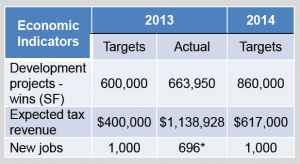 Hard to understand the significant increase in expected tax revenue when the square footage is close to the same. The organization has taken on a secretive approach – getting information out of them has been very difficult – they are not exactly media friendly. They tend to hunker down and hope that things will just blow over – an attitude and approach that applies to both staff and the directors. We recall two situations where we have asked for comment and were referred to the Executive Director who they later fired.
When the BEDC gets “repurposed” or “reinvented” or whatever they decide to call themselves they need to take on a good dollop of media “savviness” as well. This Board needs strong leadership which they are not going to be able to hire until they have a governance model in place that will guide whoever is brought in. Expect to see something come out of the Committee of the Whole later this month. Will someone within city hall suggest the existing Board be dismissed and the responsibility be brought in-house – at least until things are stabilized and we are where we should be and need to be? Is there a member of council with the courage to step forward and talk about some “out of the box” ideas. Surely Burlington can do better than this.
When Burlington was named the best medium-sized city in Canada to live in the BEDC immediately took out a full-page advertisement in a leading business magazine. It was the best they could do.

|
|















 Last November the transit people introduced a new schedule with a lot of changes – and that took time for people to adjust to the different routes and schedules.
Last November the transit people introduced a new schedule with a lot of changes – and that took time for people to adjust to the different routes and schedules.




 It will not be too long before rules like that are going to apply to seniors.
It will not be too long before rules like that are going to apply to seniors.









 What was nascent and budding – has been stunted at the administration level.
What was nascent and budding – has been stunted at the administration level.







 Heck BEDC can’t get themselves to the point where they are ready to go to market and find the person they need.
Heck BEDC can’t get themselves to the point where they are ready to go to market and find the person they need.



















 The golf course wants to spend $150,000 this year on upgrading parts of the golf course – Dennison wanted to defer that spending while the city took a closer look at the property and the opportunity he felt it offered.
The golf course wants to spend $150,000 this year on upgrading parts of the golf course – Dennison wanted to defer that spending while the city took a closer look at the property and the opportunity he felt it offered. Were anyone to ask a privately operated golf course what their competition was you would expect them to tell you exactly how many competitors they had and be able to tell you which were their closest competitors in terms of course usage and revenue.
Were anyone to ask a privately operated golf course what their competition was you would expect them to tell you exactly how many competitors they had and be able to tell you which were their closest competitors in terms of course usage and revenue.


 It would appear that the Headon Forest community haven’t taken to the idea of renaming Southampton after a police officer because the relationship with the detachment isn’t all that good to begin with.
It would appear that the Headon Forest community haven’t taken to the idea of renaming Southampton after a police officer because the relationship with the detachment isn’t all that good to begin with.










 Culture was clearly the biggest concern: with delegations from the Art Centre, who had a very spiffy presentation, Sound of Music, who finally shared their audited financial statements, Heritage Burlington who came up with a new logo that cost less than $2000, which made Councillor Dennison smile.
Culture was clearly the biggest concern: with delegations from the Art Centre, who had a very spiffy presentation, Sound of Music, who finally shared their audited financial statements, Heritage Burlington who came up with a new logo that cost less than $2000, which made Councillor Dennison smile.

 What Miller hasn’t managed to do is make the city his partner.
What Miller hasn’t managed to do is make the city his partner.










 9. Salaries saw an increase in 4.18%. Can you advise why? More staff? What’s the budgeted raise? At the city, the compensation amount is set at 1%. How much would your budget be reduced by if you also kept HR to 1%?
9. Salaries saw an increase in 4.18%. Can you advise why? More staff? What’s the budgeted raise? At the city, the compensation amount is set at 1%. How much would your budget be reduced by if you also kept HR to 1%? 16. What is the $40,000 for investment attraction, and why so low?
16. What is the $40,000 for investment attraction, and why so low? Stewart set out the problem better than he may have realized when he told the Standing Committee that
Stewart set out the problem better than he may have realized when he told the Standing Committee that  The BEDC doesn’t tell its story and when anyone goes to the internet and enters Burlington new business – there won’t be much to see.
The BEDC doesn’t tell its story and when anyone goes to the internet and enters Burlington new business – there won’t be much to see.






